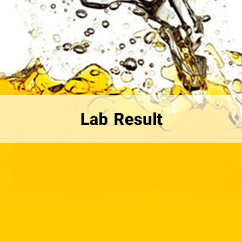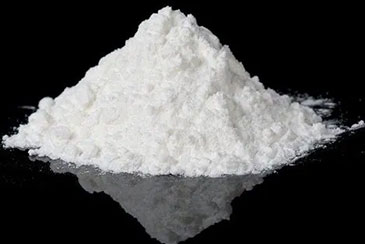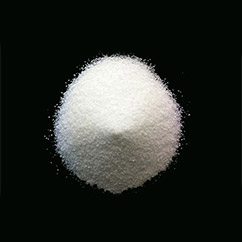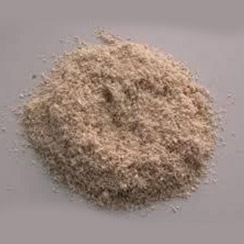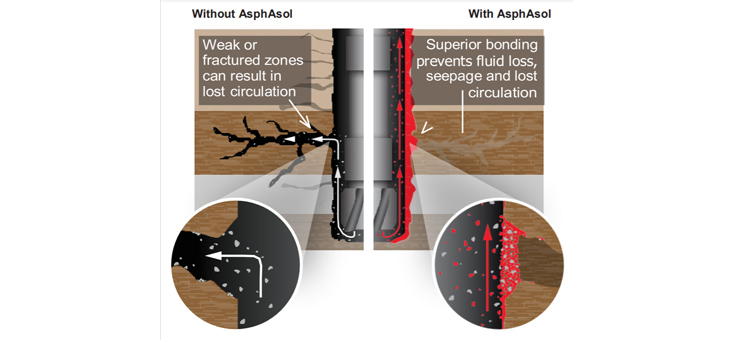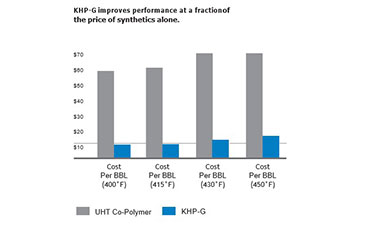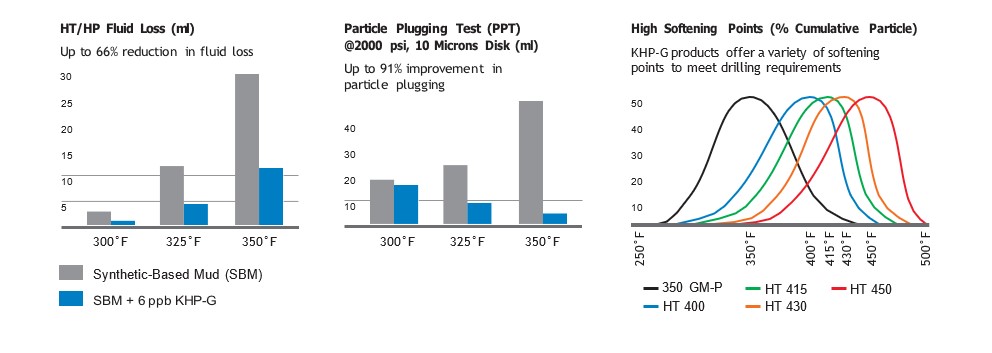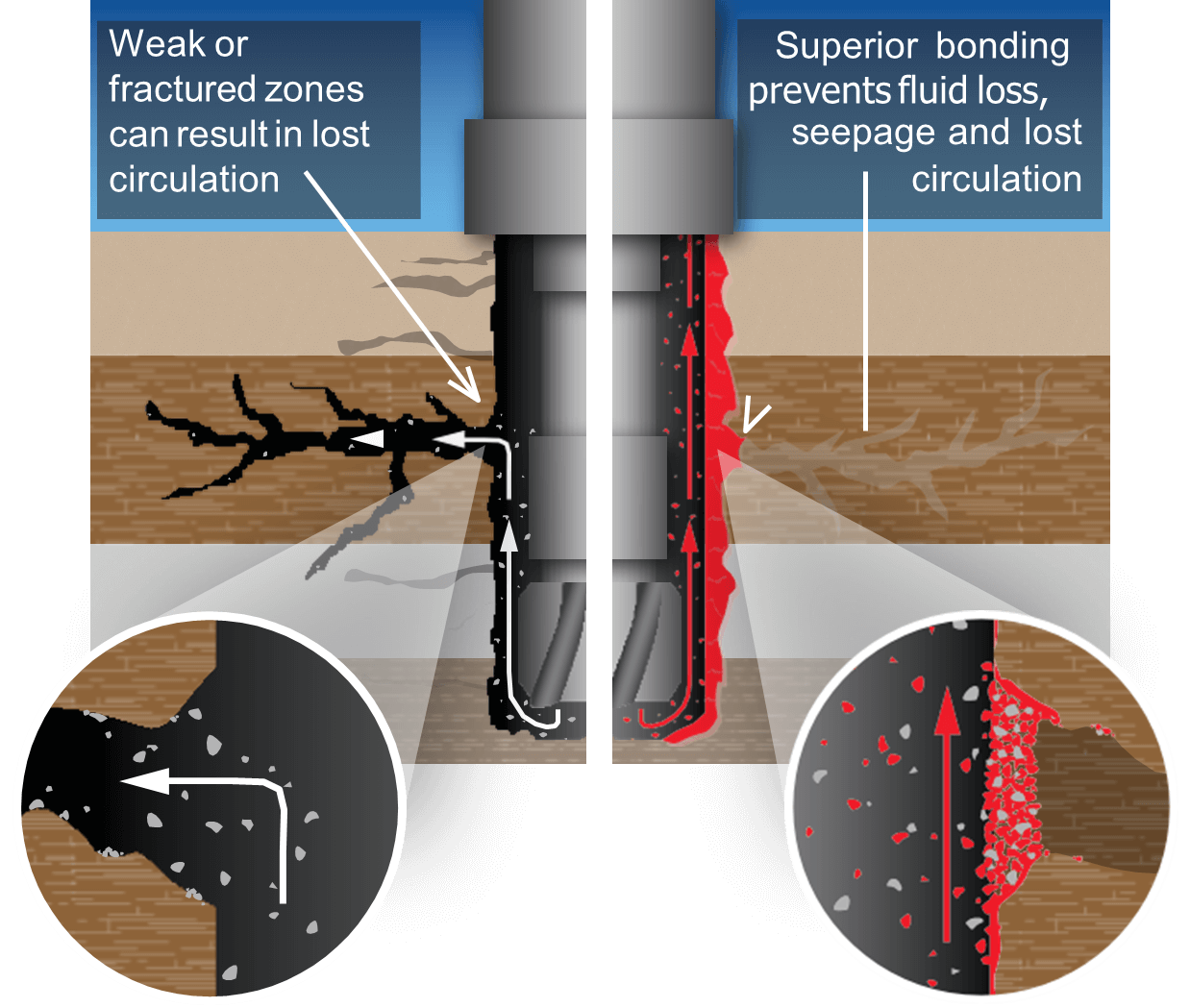Asphasol
Suggests
Don’t see the Drilling Fluids/Additives you’re looking for? We make several Drilling Fluids/Additives that are not listed here.
Connect To KhavaranParaffin
Asphasol
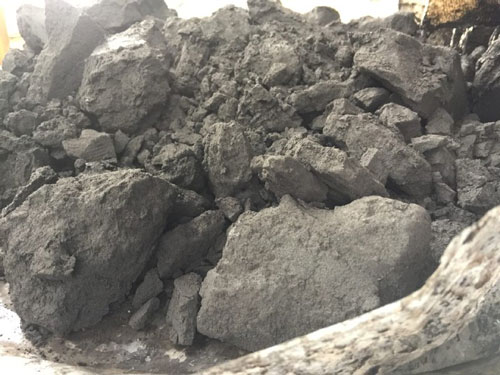
At our production centre we have the flexibility to filter and add to the products to cater for customer requirements.
shale inhibitor is a partially water-soluble, sulfonated organic material developed for use in most water-base drilling fluids.
Natural Sulfonated Asphalt/Asphasol
shale inhibitor is a partially water-soluble, sulfonated organic material developed for use in most water-base drilling fluids.
Asphasol Packing
- stabilizing shale sections,
- controlling solids dispersion
- improving wall-cake characteristics.
- high-temperature fluid-loss additive for water-base drilling fluid systems.
- contains no surfactants
AsphAsol: Performs in WBM like sulfonated asphalt. Costs 25-50% less.
AsphAsol is a cost-effective, high-performance additive effective in a wide range of water-basedsystems for both low and high temperature wells. AsphAsol is renowned as an excellent shale stabilizer.
AsphAsol disperses quickly and easily inwater-based muds
AsphAsol is a free-flowing powder that mixes easily through the hopper and disperses with only mild agitation. It is tolerant of contaminants and eliminates the need for additional surfactants or coupling agents
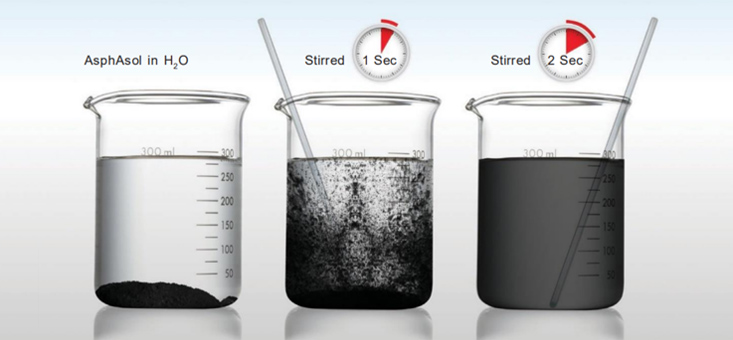
Properties and features of AsphAsol
- Free-flowing powder resists clumping
- Compatible with most water-based systems
- Disperses with mild agitation
- A naturally occurring, mined material
- Effective in both low and high temperature wells
Get the performance of sulfonated asphalt and pay 25-50% less
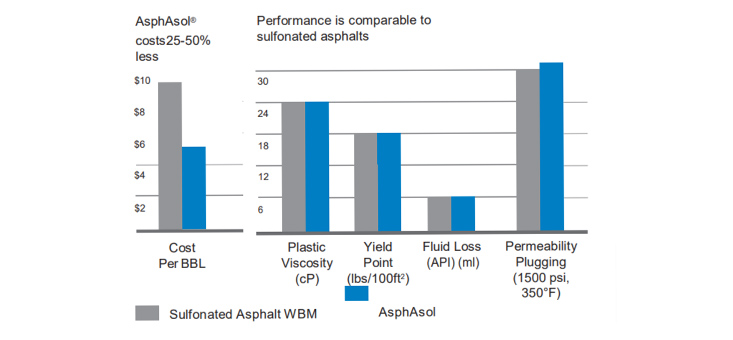
Water-Based Mud Applications
AsphAsol performs comparably to sulfonated asphalt at a much lower cost. Plus, AsphAsol requires no additional surfactantsor coupling agents, so it further lowers costs by allowing you to usefewer additives.
Ease of use, with a wide range of performance benefits
- Mixes easily through the hopper
- Controls fluid loss and seepage
- Stabilizes shales
- Prevents lost circulation
- Strengthens the wellbore
- Minimizes differential sticking
- Maintains lubricity in tight formations
- Is safe and environmentally
friendly
AsphAsol has overwhelming performance advantages over alternatives
| Costeffective | High Temperature |
Controls Fluid Loss |
Minimizes Differential Sticking |
Stabilizes Wellbore |
NonClumping | Strengthens Wellbore |
Smear Effect |
Coats & Bonds |
Minimal Odor |
|
| AsphAsol | ✔ | ✔ | ✔ | ✔ | ✔ | ✔ | ✔ | ✔ | ✔ | ✔ |
| Lignite | ✔ | ✔ | ✔ | ✕ | ✕ | ✔ | ✔ | |||
| Oxidized / Sulfonated Asphalts |
✕ | ✕ | ✔ | ✕ | ✔ | ✕ | ✔ | ✔ | ✕ | ✕ |
| Bitumen | ✔ | ✕ | ✔ | ✕ | ✕ | ✕ | ✕ | ✔ | ✕ | ✕ |
| Petroleum Coke | ✔ | ✔ | ✔ | ✕ | ✕ | ✔ | ✕ | ✕ | ✕ | ✕ |
| Coal | ✔ | ✔ | ✕ | ✕ | ✔ | ✕ | ✕ | ✕ | ✕ | |
| Grahamite | ✕ | ✔ | ✔ | ✔ | ✕ | ✔ | ✔ | ✔ | ✕ | ✔ |
| Glance Pitch | ✔ | ✕ | ✔ | ✔ | ✔ | ✔ | ✕ | ✔ | ✕ | ✕ |
Effective at controlling hole enlargement
Hole enlargement is a problem for wells drilled in the South Pars Area. On average, hole enlargement was approximately 50% in the 12.25 inch holes. Once 4 ppb of AsphAsol were added to the conventional water-based formulation, holeenlargement was reduced to 15% in the same section.
Proven to reduce torque and drag
In the South Pass Area of offshore Louisiana, the operator wanted to reduce torque and drag. Wells in this area are normally deviated approximately 30° from vertical and are drilled with a conventional lignosulfonate mud.
- Well A: Conventional and bead-type lubricants were used for torque and drag reduction.
- Well B: 3-4 ppb of AsphAsol were added at approximately 10,600 feet.
Upon measurement, the torque on well B was reduced 36% and drag was reduced 50%. Caliper log comparisons from the two wells indicated substantial improvement.
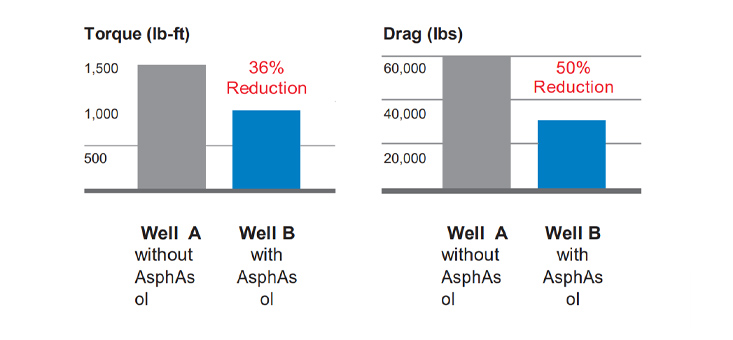
QUICK REFERENCE GUIDE FOR APPLYING ASPHASOL ADDITIVE
| Application | Material Needed |
| Asphasol Additive | |
| Stabilize shale formations | 3 to 6 ppb (9 to 17 kg/m3) |
| Impart lubricity | 1 to 3 ppb (3 to 9 kg/m3) |
| Reduce torque & drag | 1 to 3 ppb (3 to 9 kg/m3) |
| Control HTHP fluid loss | 2 to 6 ppb (6 to 17 kg/m3) |
| Thin, strong, compressible wall cakes | 2 to 4 ppb (6 to 11 kg/m3) |
| Emulsify oil into water-based mud systems | 0.5 to 3 ppb (2 to 9 kg/m3) |
| General hole conditioning (differential sticking, etc.) | 2 to 6 ppb (6 to 17 kg/m3) |
Mixing guidlines
If excessive product losses are being experienced over the shakers, it is recommended to employ coarser screen sizes during initial stages of product addition, and then switching over to finer sizes. It is not uncommon to experience a 10 to 20% loss over shakers during initial stages of additions, andin some areas may be considered normal and within acceptable limits. Asphasol solubility is much dependent upon temperature, and circulation time. Asphasol will more rapidly mix into the mud system as the fluid temperature increases. If the mud is very cool, it may be best to hold offadditions until it has a chance to warm up. An amount of Dilution may also be required during initial additions. Continual additions of Asphasol will be needed to maintain a sufficient concentration in the system if losses occur while drilling. Asphasol is consumed while depositing on drilled solids and on the well bore. It is advisable to add 50% more, one day following the initial treatment, to ensure adequate concentration. Use a conventional hopper when chlorides do not exceed 60,000 ppm. When adding to high salinity systems, pre- wetting the Asphasol with fresh water by adding through a chemical barrel or pre-mix tank will improve results.
Pre-mixing
Asphalt materials (including Asphasol Additive), may have some preliminary losses over the shaker. Precautionary actions to eliminate or reduce this possibility may be necessary. Pre-mixing is recommended even if the product is not running over the shakers, as the thorough solubility before mixing with whole mud, leads to better hole stability. If Asphasol Additive cannot be added directly to the system through the hopper, it can be added to the system using a chemical barrel or pre- mix arrangement. Add 40-50 ppb of Asphasol Additive to the base mud and then bleed it into the active system. Agitation, stirring or circulation may possibly be required in the pre-mix tank or chemical barrel to prevent excessive settling. Pre-mixing in freshwater is recommended as the bestmethod, even when adding to an oil base mud system. Make up salt such as calcium chloride can be added to the pre mix, but this is usually not necessary asthe amount of fresh water added to the system via concentrated pre-mix solutions will be negligible.
Pre-mixing in freshwater
Mixing in freshwater might be the simplest and cheapest solution. Mix 40-50 ppb of Asphasol Additive in a slug pit of freshwater. There could be
PRE-MIXING IN HIGH SALT MUDS RIG SITE MIXING
AsphasolAdditive can usually be mixed into high salt (60,000 ppm chlorides and up), high density drilling muds without problems if some extra steps are followed. If
enough time is available, both products may be added gradually over several days to an existing system allowing both time and temperature and shearing at the bit to disperse the product. This slow addition of the product reduces losses at the shale shaker which would be expected under these conditions. However, if hole conditions require large amounts of Asphasol Additive be added quickly, it is best to prewet
the Asphasol Additive with freshwater in a separate mixing tank. In fresh water
large amounts of either product up to 200 ppb may be mixed to create a slurry that may be added direct to the mud system without much loss at the shale shaker.
Download ASPHASOL MSDS & TDS File
KHP-G
Proven safe and effective for deepwater operations
The deeper you look, the more benefits you’ll see
KHP-G has been proven safe and effective in more than 60 years of oilfield performance. With natural bonding and plugging properties and a high softening point, it is a cost-effective, multi-purpose additive.
- Extends thermal life 10% or more
- Prevents lost circulation
- Minimizes differential sticking
- Stabilizes shales
- Performs in WBM and SBM
- Performs in HP/HT environments
- Reduces cost polymers
- Delivers higher performance with no HSE risk
KHP-G reduces costs more than 80%
KHP-G is a fraction of the cost of premium polymers. With its high softening point, it delivers greater cost advantages at higher temperatures.
KHP-G extends thermal life
PALAYESH PARAFFIN KHAVARAN have yielded variations of uintaite with a range of softening points. Carefully selected varieties of pure Gilsonite® have been combined to perform to customers’ specifications, at temperatures as high as 500°. Adding KHP-G extends the thermal life of synthetic-based mud and water-based mud formulations by 10% or more.
A case history: KHP-G eliminates deepwater differential sticking
An international oil company drilling below 16,000 ft. in the Gulf of Mexico encountered a major pressure regression, and the pipe became differentially stuck. Unable to free the stuck pipe, the oil company and the drilling fluids provider decided to sidetrack the well, re-drilling the section with a zero fluid loss WBM.
Onsite testing indicated that sized particles and calcium carbonate in combination with high concentrations of KHP-G resulted in < 0.5 cc HPHT fluid loss, and fluid loss was nil as measured with a permeability plugging apparatus. Using the reformulated WBM, drilling proceeded through the major pressure regression without any sticking tendencies in the problematic wellbore.
KHP-G is proven under pressure.®
Unique Bonding And Plugging Properties Prevent Formation Damage
KHP-G forms a physical and chemical bond with permeable formations, creating an effective seal to prevent the passage of drilling fluid. By uniquely
functioning as both a malleable and solid plugging agent, KHP-G controls fluid loss and seepage, prevents lost circulation and protects reactive and low-reactive shale surfaces, even at elevated bottomhole temperatures.
KHP-G is naturally better
KHP-G is a naturally occurring hydrocarbon resin found only in northeastern Utah. KHP-G has significant health advantages over synthetic products.
- KHP-G is:
- Non-toxic (unlike coal or fly ash)
- Non-carcinogenic
- Non-mutagenic
- No extreme safety measures are needed to handle KHP-G

 فارسی
فارسی
